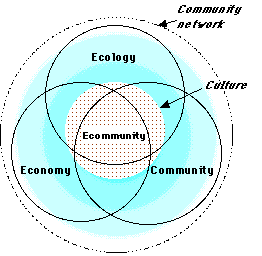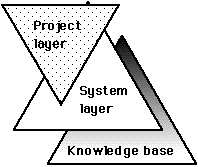Summary |
要約 |
>Top
0. Prologue:
- This is a report from a reading circle at Glocom, attended
by the author of a book of "Ecomoney - from big ban to more
humane society".
- It is unique and surprising that such ecomoney is proposed
by the author who is an active officer of MITI, and experienced
at the Board of Financial Supervision Committee, playing one of
key players of present money economy.
|
0. プロローグ:
- Glocomで、著書である加藤敏春氏を迎えて、「エコマネー」~ビックバンから人間に優しい社会へ~ の読書会が行われた。
- 現職の通産官僚であり金融監督庁設立準備室主任も経験した著者が、全く異次元の環境・福祉・コミュニティ重視の温かいお金を提言するという意外性がまずおもしろい。
|
>Top
1. Two different vectors:
- There is a new concept of 'ecomoney' (= ecological money), forming
contrast to the recent IT technology brings electronic money (e-money)
pursuing more efficient, global and virtual currency.
- The vector of ecomoney points to the different direction of development
of currency enabling more ecological features, and emphasis of local
and diversified community with more reality.
- Humankind spent long times to create culture, where present monetary
system is also included, but the recent monetary economy invented
financial derivatives causing big ban in the end of the century.
Will the direction of such monetary development be appropriate?
Or will be necessary to change the way of thinking?
- The author draws an analogy between nucleus and mitochondria in
a cell. The ecomoney corresponds to mitochondria whose gene is only
transmitted by female. Such phenomenon looks like a currency which
functions as local settlement without creating any credit.
- The present currency aims more and more efficiency, simplicity,
selfishness, selection, and survival of the fittest, while ecomoney
stresses to play instinct, leisure, full of variety, altruistic
behaviors, and more local activities.
- The idea of such ecomoney is welcomed since the publishment of
the book by grass root movements at various local communities.
|
1. 二つの別ベクトル:
- 21世紀を目前に控え、一方では効率化・グローバル化・バーチャル化という方向へ、他方では多様化・ローカル化・リアル化という全く別の方向を向かうベクトルが進行している。
- 人間は長い時間をかけて文化(貨幣もそのひとつ)を創造してきたが、昨今のデリバティブや金融不況からビックバンへの方向に対応するだけで21世紀のマネー経済はいいのかという発想の転換が原点にある。
- それは、著者の比喩によれば、通常のマネーを細胞の核の遺伝子とすれば、信用創造機能をもたないローカルな決済機能だけをもつエコマネーは、あたかも女性だけが伝えるミトコンドリアの遺伝子に相当するという。
- これは人間が効率性を重視し淘汰による優勝劣敗の原理の中で利己的で単一化を指向してきた反面、他方では遊戯や余暇を楽しむむしろ利他的で多様性を重視する原理を掘り起こす試みでもある。
- 著者によるエコマネー構想の発表以来、すでに各地で実証的な試みが多数行われている。
|
>Top
2. Dichotomy in 20th century:
- In 20th century everything was recognized by dichotomy way of
thinking such as 1) business and leisure, 2) man and woman, 3) currency
and non-currency, 4) public and private, and the former is usually
regarded as main and the latter is subordinate. Consequently this
dichotomy made the social system composed of the layers of public,
private and common. Value of the layers of public and private are
measured by currency and enhanced as far as money economy.
- Such trend typically occurred since 1970s, when the transborder
transaction became common apart from the real economy in the form
of 'securitization. Securitization means division of a loan into
small securities easy to be traded in the capital market. Various
method of risk management and conversion of credit risk to market
risk developed in globalized financial market. And it is prevailing
that the global rule of measurement such as accounting based on
current value, ROE, BIS restriction starting from Anglo-Saxon societies,
then to others.
- In 1981 financial derivatives transaction (such as swap, option
and forward) has grown into just like a selfish gene running about
in the global market in a scale of 100 times bigger than the size
of real economy. Thus global money war was provoked. In Japan bubble
economy collapsed after 1990. This is described as another defeat
of world monetary war, causing $4 trillion loss in capital and $6
trillion loss in land. The sum of 2 years of Japanese GDP($4.9 T/99)
was lost between 1990-95, which corresponds to the total loss during
the last world war II.
|
2. 20世紀的二分法:
- 20世紀は何でも二分割法の対立概念を強調してきた。仕事と余暇、男と女、貨幣と非貨幣、公と私とう二分割の発想であり、いつも前者が主で後者が従という扱いであった。この二分法は、結果として、公・私・共階層からなる社会システムを、貨幣価値で表現できる公・私の肥大化を招き、マネー経済化を高度化させた。
- 分水嶺は、70年代から始まる実体経済と切り離して、トランスナショナル・エコノミーを目指した「証券化」(Securitization)ににある。証券化とは、融資を分割して証券に転換し、それを資本市場で取引することである。リスク管理をうまく行い、信用リスクを市場リスクに転換することで金融のグローバル化が進展した。また、グローバルな取引ルールとしての、時価会計、ROE、BIS規制などアングロサクソンのグローバルスタンダードが広がった。
- 1981にはデリバティブ (スワップ、オプション、先物) が開発され気まぐれな遺伝子となって実体経済の100倍もの規模で世界市場を駆けめぐっているのである。そして現在グローバル・マネー・ウォーズが起きている。その結果、日本のバブル経済の崩壊が起こった。マネー敗戦の結果、株式400兆円、土地600兆円、日本のGDP (495兆円/1999)の2年分、第二次世界大戦の金額被害に相当する額の全損失が1990-95年の間に起こったのである。
|
>Top
3. The Limit of Japan System:
- Postwar Japan became non-risk taking society adopting the following
typical systems:
- Stable employment;
such as lifelong employment, seniority wage system, enterprise
union,
- Indirect finance;
by the main bank (causing lower equity capital, cross-share
holding by keiretsu),
- Protective policy;
called convoyed vessels method (=over restriction by the government.
These measures caused vicious cycle of lower capital cost, lower
profit, and consequently stronger export competitiveness.
There are still other problems to be solved in Japan:
- Technical paradigm shift:
from mass consuming industries like automobile, home electronics
and semiconductor to intellectual industries like information-telecom,
biochemical industries.
- Temper of younger generation:
more conservative or apathetic stance, probably due to smaller
number of younger generation, showing little interest in high
risk high return style.
- Serious financial deficit:
Uncertainty of pension fund operation; uncertainty of future
pension system, causing Dutch rolling phenomenon of the policy.
- Volatility of yen:
The Currency crises in Asian countries and the adverse effect
of Fort Euro market.
- Under such severe environment, Japan is compelled to perform financial
big bang seeking free, fair and global market in coming 2001.
|
3. 日本型システムの限界:
- 戦後の日本はリスクをとりにくい社会となっている。
- 安定雇用:
終身雇用、年功序列、企業内組合
- 間接金融:
主力銀行による間接金融中心、低い自己資本比率と系列による株式持ち合い
- 護送船団方式:
政府による過剰な規制。この結果、低資本コスト→低収益→輸出競争力というメカニズムができた。そして更に課題が重なっている。
- 技術パラダイムシフト:
自動車・家電・半導体のような大量消費型産業から情報通信、バイオなど知的集約産業へ
- 若年層の保守化と少子化:
ハイリスク・ハイリターンを指向すべき次世代が少ない。
- 深刻な財政赤字:
年金不安など、政策のダッチロール現象。
- 円のボラティリティ:
アジアの通貨危機とユーロ圏諸国の要塞化による相対的影響。
- このような体調不良の中で、日本経済はグローバルスタンダードに基づく「フリー」「フェア」「グローバル」の金融ビックバンを2001年に実施せざるを得ないのである。
|
>Top
4. Prospect for EcoMoney:
 - The factors needed for 'Ecommunity' are unique local culture and
participation of entrepreneurs as well as economy, ecology and community
factors.
- Ecommunity is designed to reconverge in 21st century the factors
which were once dissolved due to pursuing efficiency in 20th century.
- It also intends to create new culture by collaboration of industrial,
academic, public and private sectors.
- 20th century was designed for simplified target and principle
measurable by currency, which brought rapidly growth, corporate-centric
society and money economy, but on the other hand proved the limit
of capacity of global environment, and caused aged society with
less children in advanced countries.
- In 21st century, there is a reason of proposal of ecoomunity which
realizes sustainable community with variety of hobbies, volunteer
activities and network-driven society.
- The observation of symbiosis in life or gene level suggests us
that the human made society should have more human features.
|
4. "エコミュニティ"への展望:
- エコマネーの使われる "Ecommunity" には、経済+エコロジー+コミュニティーに加えて、地域独自の文化と市民起業家を加えた計5要素が必要である。
- これは20世紀が元来一体であったが効率追求の結果、解体した要素を、21世紀には再びまとめる流れであり、産学官民による新たな文化創造であるとする歴史認識である。
- 20世紀の特徴は、高度成長、企業社会、マネー経済化の示す単一原理であったが、一方で地球環境の限界を示し、先進国では少子高齢化の問題を提起した。
- 21世紀に向かっては、地縁・好縁(趣味)・事縁(ボランティア)・情縁(ネットワーク)からなる多様性に富むSustainable
communityとしての"Ecommunity"を展望する所以である。
- これは生命や遺伝子のレベルの性質の異なるものの共生でもよく見られる現象であり、"人間が作る社会は凡そ人間的なものにならざるを得ない"という洞察である。
|
>Top 5. LETS (Local Exchange Trading System):
- Several experiments of ecomoney have already existed. It is a
type of local money called LETS (Local Exchange Trading System),
starting first in Canada, then proliferated in 1,000 areas such
as England, US, Australia, etc.
- LETS is a local money used in a particular area, circulated at
local shops and various local services of medical, carpenter, cleaning,
gardening and baby-sitter, etc. The prices are listed on the web
and the barter transaction is paid by the local currency called
'Green Dollar'. Green dollar is used only for the payment, without
having any credit function. The account of transaction must be balanced
in the community.
- LETS shows the idea of ecomoney which aims circulation of goods
and services in the local community, decrease of load to the environment,
and promotion of self-sustainable local economy.
- However, LETS must depend on bona-fide civilness, because it has
no responsibility of repayment of debt, allowing easy escape from
the community. Also LETS indicates difficulty of independence from
outside economy in a way of showing the standard prices of goods
and services. Tax on LETS is still unsolved issue.
|
5. LETS (Local Exchange Trading System):
- エコマネー的な試みは実はもう存在している。カナダで始まり英国、米国、フランス、豪州などですでに1000ヶ所で広く浸透しつつあるLETS (Local Exchange Trading System, 地域経済信託制度)と呼ばれるローカルマネーである。
- このLETSは、特定地域内だけで流通するローカルマネーである。地域の小売店、医者、大工、クリーニング、庭の手入れ、ベビーシッターなどWeb上で相対で取引価格が決定される。地域内で通用する"Green
Dollar"という名目上の貨幣単位でバーター取引が広がる。LETSは、決済機能はもつが、信用創造も発生せず、取引による勘定はバランスするようになっている。
- 地域内での物質循環、環境負荷の軽減、地域経済の自律性の強調などまさにエコマネーの方向を目指している。
- 但し、LETSは、債務返済義務がなく、勝手に離脱できるなど民度(Civilness) に依存せざるを得ない。また標準小売価格を表示するなど、LETSが外部の貨幣経済からの脱皮することの難しさも示している。税徴収もこれからの課題である。
|
>Top
6. EcoMoney Experiments in Japaan:
- As the first stage of ecomoney experiment should limit a linkage
to the outside economy, enclosing in local services of environment,
welfare and culture, and only related to a part of public services.
Such enclosed services are needed to proceed to the next step, the
author points.
- Asian countries have various mutual loan type of services. In
Japan they are called 'tanomoshiko' or 'mujin', a
tradition of rotated mutual credit union. History has long tradition
of plural currencies. In Edo period, each feudal domain (han) has owned local currency called hansatsu. The currency in
Japan has unified when war expenditure is needed for Japan-Russia
war in 1904-05.
- There are various experiments of ecomoney promoted in various
areas. In Yokosuka city, IC card type of ecomoney is used for different
type of welfare and public services. Similar activities are under
process at such as Nakamura city in Kochi Pref., Komagane city,
Ina city, Iida city, Yamada village, Okinawa, Hokkaido, Sendai,
Musashino city near Tokyo and others.
|
6. 日本でのエコマネー実験:
- エコマネーの第一段階は、外部貨幣経済とは、一部行政サービスのみをに限定的にリンクさせ、むしろ環境・福祉・文化サービスは地域内で閉じて、他で流通させない仕組みからスタートして熟成を待つべきと著者は提言する。
- 日本を含むアジアには、共同体間の相互信頼に基づく「頼母子講」や「無尽」などの回転信用組合的な伝統があったように、通貨が一つである歴史はむしろ短い。日本では江戸時代には各種藩札があり、単一通貨になったのは、日露戦争の戦費調達以降というように、併行通貨制はおかしいことではない。
- 日本でのエコマネー実験はすでに各地域で進められている。横須賀市では福祉介護、ゴミ減量など多様な価値を流通する多目的ICカード化したエコマネーによって異なるサービス間の価値を流通させている。その他高知県中村市、駒ヶ根市・伊那市・飯田市、山田村、沖縄、北海道、仙台、武蔵野市などコミュニティー活動の活発な地域で多様な実験が進行中である。
|
>Top
7. Hypertext type of social structure:
 The
author described the ecommunity by three layered hypertext like
structure. The center is 'System Layer' representing the
present money economy with the value of simplicity. The
author described the ecommunity by three layered hypertext like
structure. The center is 'System Layer' representing the
present money economy with the value of simplicity.
- Above this there is 'Project Layer' composed of corporation
and NPO sharing common vision of creature of new business and solution
for community problems.
- Under the system layer, there is 'Knowledge Base Layer'
which accumulates and reorganize the knowledge, technology and culture
gained through the above two layers.
- These three layers will coexist and interchange knowledge, creating
new ideas for both market and community.
We can observe initial model at Silicon valley area in US being
participated by various civil entrepreneurs.
|
7. ハイパーテキスト型社会構造:
- 著者は、"Ecommunity"を3つの層からなるハイパーテキスト型の社会構造として描いた。
- すなわち、従来の単一化に向かうマネー経済である「システム層」の上層にビジョンを共有する企業やNPO参加による新ビジネスの創造やコミュニティの課題解決のための「プロジェクト層」が生成される。
- また下層には上の2層で得られた知識・技術・文化が再分類・再編成される「知識ベース層」存在する。これらの3層が同じ社会の中に共存・交流しつつ知識創造が行われる市場+共同体の共存する社会がEcommunityであるとする。
- このモデルはすでに米国シリコンバレーの多様な市民起業家による実践にも見られる。
|
>Top
8. Time-valued society:
- The history thus far has been commodity-valued society. Money
revolution in 1990s reached the summit of money-value society, and
showed its excess.
- Value of 'time' will be a new social measurement in the next millennium,
that is, time will be invaluable resource of measuring the value
of happiness of the people.
- Why a note of 10,000 yen values 10,000 yen? Because the other
people recognize and willing to receive it. The currency world is
based an endless chain process of desires of the others.
- The author proposes to change the paradigm through 'value of time'
in 21st century.
- The present public organization of 'Leisure Development Center'
should be soon renamed as 'Free Time Network', to create ecommunity
with autonomous and disperse governance combined with economy, community
and ecology.
- Experiments of ecomoney are continued at various local communities,
supported by NPO and the Internet media. Open and voluntary movement
such as a case of Linux development cannot be bypassed which shows
similar challenge to create a new type of community.
- Solvitur ambulando (solved by walking) methodology
backed by the will and hope of the people may change the history.
|
8. 「トキ」が重視される社会へ:
- 「モノ」中心の長い歴史を経て、90年代のマネー革命で「カネ」の機能が頂点に達し、その行き過ぎが指摘される中で、21世紀の新たな社会尺度としての「トキ」を重視、すなわち時間が資源となり、豊かさから幸せへの尺度重視する社会を展望している。
- なぜ1万円札に1万円の価値があるのか?それは他人がその価値を認めて受け取るからである。即ち、他者の欲望の連鎖のプロセスが貨幣の世界である。
- これを21世紀には時間という横串で人間を起点にしたパラダイムに変えようと著者は提案する。
- 「余暇開発センター」は発想を変えて「自由時間ネットワーク」と改称し、そしてエコノミーとコミュニティーとエコロジーの3つの輪の重なる所に自律分散的なガバナンスである「EcoCommunity」を創造しようというのである。
- 各地域でのNPOによるインターネット活用の動き、そしてLinuxに象徴されるようなオープンでボランタリーなソフトウェア協同制作の動き、これらは大きな流れとなって新しい社会のあり方までも模索しようとしているのであろうか?
- 人々の意志と希望を満たすような実践的な試みは歴史を変えるかも知れない。
|

 The
author described the ecommunity by three layered hypertext like
structure. The center is 'System Layer' representing the
present money economy with the value of simplicity.
The
author described the ecommunity by three layered hypertext like
structure. The center is 'System Layer' representing the
present money economy with the value of simplicity.